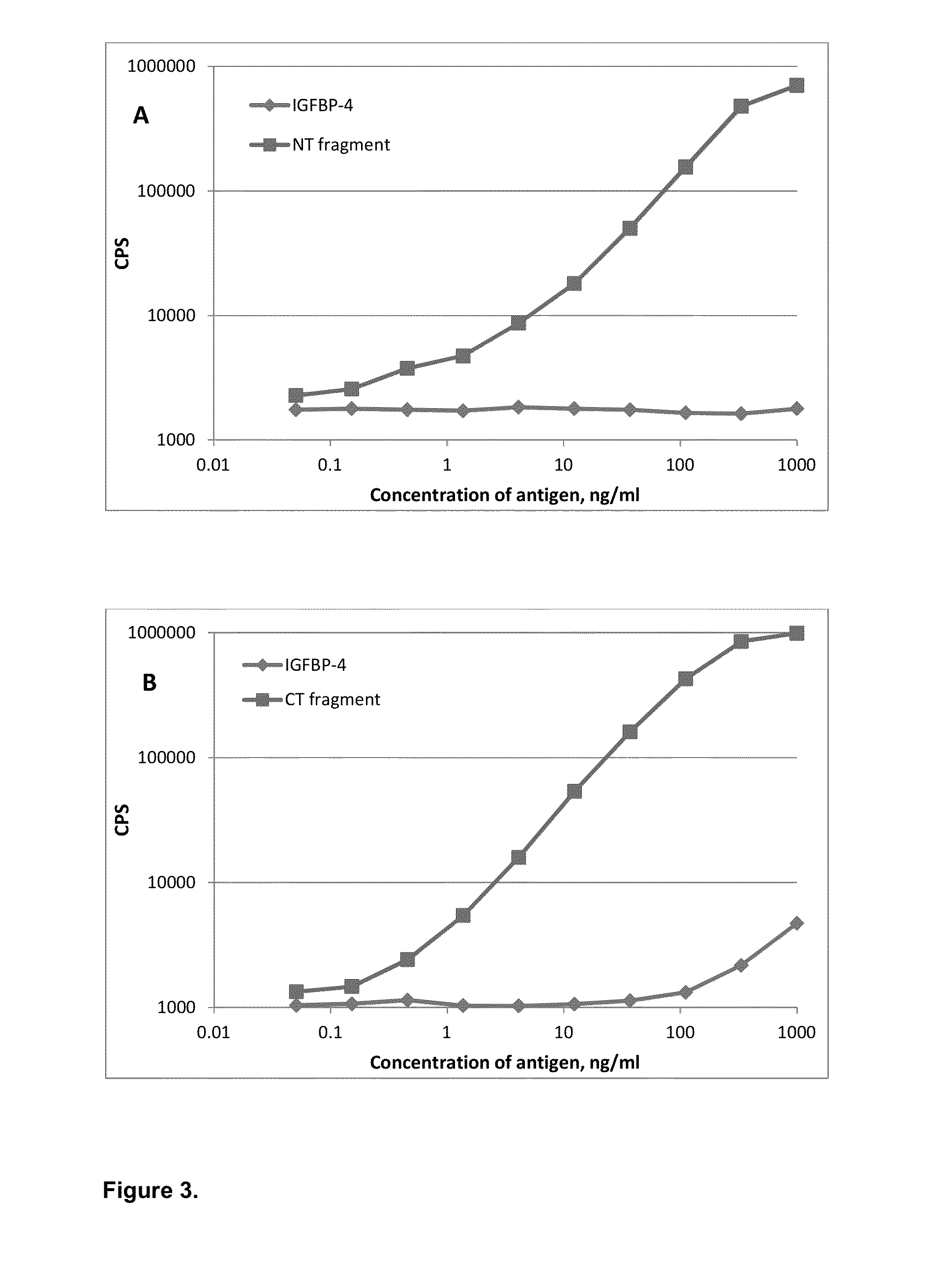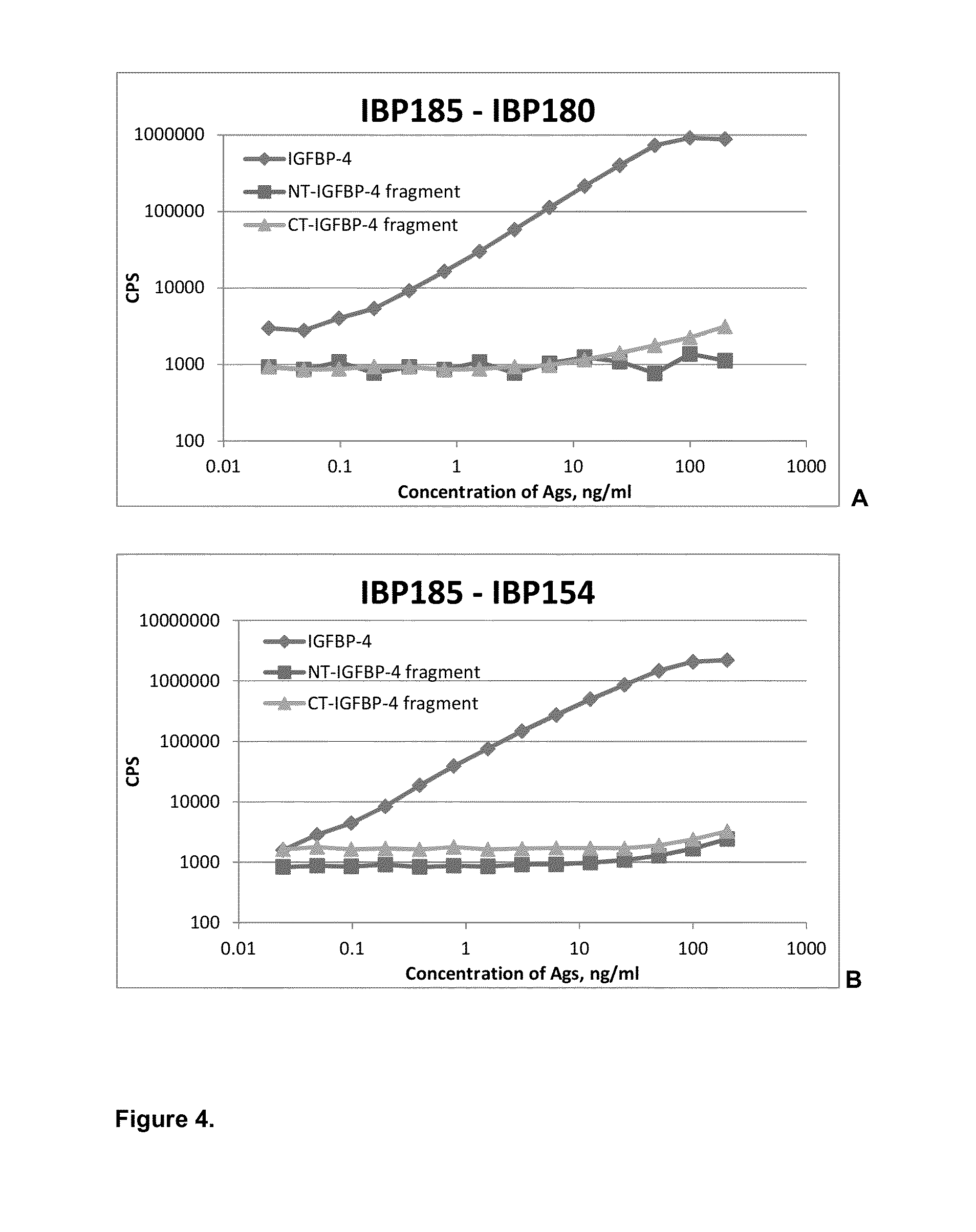Method for determining the risk of cardiovascular events using igfbp fragments
a technology of igfbp fragments and cardiovascular events, which is applied in the direction of disease diagnosis, instruments, material testing goods, etc., can solve the problems and achieve the effect of increasing the risk of major adverse cardiovascular events
- Summary
- Abstract
- Description
- Claims
- Application Information
AI Technical Summary
Benefits of technology
Problems solved by technology
Method used
Image
Examples
example 1
Generation of Mouse Monoclonal Antibodies Specific to Novel Proteolysis-Mediated Epitopes of IGFBP-4
[0031]Synthetic peptides obtained for mice immunization:
IGFBP-4 Peptide-1: CHFAKIRDRSTSGGKM;IGFBP-4 Peptide-2: KVNGAPREDARPVPQC.
[0032]IGFBP-4 Peptide-1 and IGFBP-4 Peptide-2 (FIG. 1) were synthesized using solid-phase Fmoc chemistry. Peptides were prepared on p-alkoxybenzylalcohol resin. After cleavage from the resin, the crude peptide preparation was purified by reversed-phase high-pressure liquid chromatography.
[0033]C18 preparative column was applied with a gradient of 0.1% trifluoroacetic acid in water and 0.1% trifluoroacetic acid in acetonitrile. The purity (>95%) was determined by analytical C18 high-pressure liquid chromatography and mass spectroscopy (matrix-assisted laser desorption / ionization mass spectrometry with accuracy±0.5 Dalton).
[0034]IGFBP-4 Peptide-1 contained the amino acid sequence identical to IGFBP-4 fragment 122-135 with one additional cysteine residue from th...
example 2
Generation of Mouse Monoclonal Antibodies Specific to Intact IGFBP-4
Immunization of Mice
[0044]Five BALB / c mice were immunized five times with human recombinant IGFBP-4 expressed in mammalian NSO cell line. The protein was obtained from Sigma Chemicals, St. Louise, Mo. First immunization: intraperitoneally 0.2 ml of 5 μg IGFBP-4 in PBS with 60% Freund's complete adjuvant. Second immunization: on day 30, intraperitoneally 0.2 ml of 2 μg IGFBP-4 in PBS with 60% Freund's incomplete adjuvant. Third immunization: on day 60, intraperitoneally 0.2 ml of 2 μg IGFBP-4 in PBS.
[0045]Twenty days after third immunization mice with the highest titer of protein-specific antibodies were selected for the following immunizations and hybridization. The mice were intravenously injected for a fourth time with 0.2 ml of 2 μg IGFBP-4 in PBS. The last intravenous injection was performed on the next day according to the same protocol (fifth immunization). Two days later, spleen of immunized mice was sterilel...
example 3
Design of Sandwich Immunoassays for Quantification of IGFBP-4 Fragments
[0047]Specificity of affinity-purified monoclonal antibodies was also checked in sandwich immunoassays (FIG. 3). Several groups of specific antibodies were tested in sandwich immunoassay in order to find combinations with required properties. Monoclonal antibodies specific to proteolytic neo-epitopes were tested with monoclonal antibodies specific to the intact (full-length) IGFBP-4 to develop sandwich immunoassays for specific determination of IGFBP-4 proteolytic fragments regardless of the presence of intact (full-length) IGFBP-4. Several sandwich assays utilizing one monoclonal antibody specific to proteolytic fragment of IGFBP-4 (N- or C-terminal; cross-reaction with full-length molecule less than 5% in indirect ELISA) and another MAb, recognizing any epitope of intact IGFBP-4, were developed. Generation of mouse monoclonal antibodies specific to intact IGFBP-4 is described in Example 2. To perform sandwich f...
PUM
| Property | Measurement | Unit |
|---|---|---|
| concentration | aaaaa | aaaaa |
| concentration | aaaaa | aaaaa |
| concentration | aaaaa | aaaaa |
Abstract
Description
Claims
Application Information
 Login to View More
Login to View More - R&D
- Intellectual Property
- Life Sciences
- Materials
- Tech Scout
- Unparalleled Data Quality
- Higher Quality Content
- 60% Fewer Hallucinations
Browse by: Latest US Patents, China's latest patents, Technical Efficacy Thesaurus, Application Domain, Technology Topic, Popular Technical Reports.
© 2025 PatSnap. All rights reserved.Legal|Privacy policy|Modern Slavery Act Transparency Statement|Sitemap|About US| Contact US: help@patsnap.com



